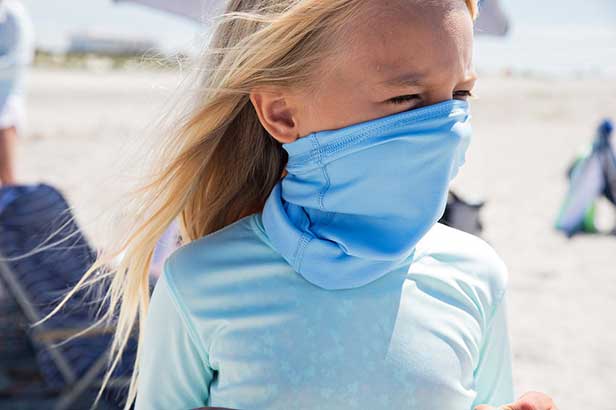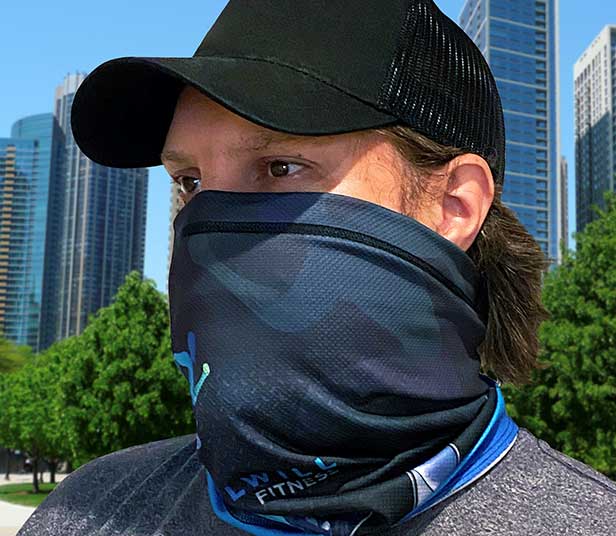News August 14, 2020
Gaiter Makers Take Issue With Duke Mask Study
Industry suppliers say not all gaiters are the same and want university researchers to test the effectiveness of their higher-quality neck gaiters.
Not all neck gaiters are created equal. That’s the message promo suppliers want the general public to understand after a Duke study testing various types of face coverings went viral.
Researchers tested 14 types of coverings, from N95s and cloth masks to a bandana and neck gaiter, using a simple setup that includes a laser, cellphone and box to determine how many respiratory droplets passed through each fabric. The initial study noted that the gaiter the researchers tested proved less effective at helping to curb the spread of the coronavirus than wearing no mask at all.
“They said it was a thin poly-spandex fabric,” says Christopher Bernat, chief revenue officer of supplier Vapor Apparel (asi/93396), which has been selling neck gaiters for a decade. “That doesn’t tell us the grammage or weight or weave. … We know it’s got poly and spandex, and we don’t know much else.”

Vapor Apparel offers sun protection gaiters that come in multiple sizes, including a youth version.
Just as there are many different types and styles of masks – all with different thicknesses, fit and construction – so too are there variations in the types of gaiters available. And sizing also plays a role in a gaiter’s effectiveness, Bernat says. Martin Fischer, the Duke physicist who designed the mask study, has said in interviews that the gaiter they used was “pretty thin” and got thinner when stretched over the mouth and nose. “If you hold up the fabric in front of your eyes, you can see light through it,” Warren S. Warren, a Duke professor involved in the mask study told the Raleigh News & Observer. “I think that gives a pretty good rule of thumb for asking if the fabric is doing any good.”

Toddy Gear offers this Cooling Active Band (ICEI705) that is made from 155 gsm polyester, more than double the fabric weight of what was tested in the Duke study, Emery says.
As the mask study’s findings went viral this week, spreading to national newspapers and across TV news, the effects in the promo industry were almost instantaneous, some suppliers say. “We felt the backlash of that study immediately,” says Jason Emery, vice president of Toddy Gear (asi/91411). “People were canceling orders. … The general public is like, ‘Oh, I’m throwing all my gaiters away.’ … This study is damning because it’s not specific.”
Pop! Promos (asi/45657) say they’ve also received many questions from clients regarding the Duke study in the last few days. CEO Erin Reilly and President Sterling Wilson pointed out in an email to Counselor that their company’s Brandana (a neck gaiter-like product) isn’t a piece of medical protective equipment, though it does meet most state and local guidelines for use as a face covering. “Thousands of leading brands across the country have purchased Brandanas and Branditos as face coverings for their employees, customers and other stakeholders because they are comfortable, one size fits all and offer a huge imprint area,” they wrote. “We don’t see this [study] changing that.”
They also note that they aren’t surprised that two- and three-ply cotton masks are more effective than a single layer of polyester, since that’s been the guidance from the Centers for Disease Control and Prevention (CDC) all along. Still, “A lot of hasty research has been done during this pandemic, and a lot of misinformation has been spread,” they wrote. “So, we are withholding judgment on any claims that wearing a Brandana is worse than wearing nothing until a medical research team publishes a controlled study on the subject.”
To Emery, “A gaiter is no different than a mask. It’s just a piece of material that’s sewn a certain way.”
The important thing is doing the due diligence with testing of the fabric itself. Toddy Gear’s gaiter, what it calls an Active Band, is 155 grams per square meter (GSM). The supplier performs a “candle test” to show the fabric’s droplet-inhibiting properties. Essentially, the test involves holding a lit lighter two feet away from the gaiter, then determining whether you can blow the flame out through the fabric. Though Emery admits it’s not a scientifically proven measurement, it’s a compelling visual to show the fabric is working as intended.
Toddy Gear does a “candle test” to show the effectiveness of its gaiters.
When Vapor Apparel started making gaiters 10 years ago, the supplier consulted with winter sports enthusiasts to see what they were looking for. The resulting Solar Performance Gaiter is made of a 135 GSM fabric, features a mechanical stretch that “pulls itself closer together simply based on the weave,” and offers UPF 50+ sun protection. It’s also extra-long, so that it can be doubled up, a feature cold-weather athletes were clamoring for. Bernat notes that in the past the product didn’t actually sell that well because it was higher-quality and thus cost more. “Now all of a sudden, people want a good one,” he adds. “They want one that’s not cheesecloth.” In the past two months sales of its neck gaiters were up 450%, Bernat told the Reporter & Observer.
When the Duke study started to go viral, Bernat says his company decided to take a stand. “It takes a certain level of confidence to call the Washington Post … and say we don’t agree with a story,” he says. “We’re actually getting a lot of phone calls here that are very positive.”
Gaiter manufacturers in the industry say they want Duke researchers to go back and test a wider variety of the neck bands, particularly the higher-quality ones made of thicker-weight fabric. Vapor Apparel has already overnighted its products to the university in the hopes that they’ll find time to test the product, and Bernat says he’ll happily post the results of any such test publicly if they do.
Duke researchers say their study was never meant to be a comprehensive test of all types of masks and the materials they’re made of. Rather, it was to demonstrate how easy it would be to test their effectiveness. The lab has received many requests to test other masks and products since the proof-of-concept study was released Friday, Aug. 7 in the journal Science Advances. “We would have no problem accepting samples that we could test, at some point, to represent the range of what is out there,” Warren told the News & Observer. “But we would very likely keep the brand anonymous (as we did with the commercial ones we tested). We are not interested in becoming the ‘Duke facemask certification facility.’ ”
Not All Gaiters Are Created Equal from Chris on Vimeo.
Chris Bernat of Vapor Apparel responds to the viral Duke study on face masks.
Suppliers suggest that promo distributors, with their help, should educate clients on the merits of gaiters – and point out the difference things like fabric weight can make in effectiveness. “A lot of people are trying to make these decisions, and these articles are landing on their desks,” Bernat says. “A good-quality gaiter can be part of an effective [coronavirus-prevention] plan that should also include social distancing.”
